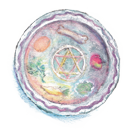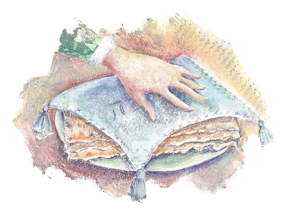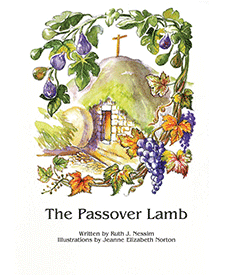- The Passover Story
- A Walk Through the Seder
- The Messianic Connection
- Free At Last
- CJFM Passover Seder Schedule
- Host Your Own Seder
Passover-The Messianic Connection
Order these
resources from MessianicSpecialties.com
 The central theme of Passover is deliverance, and it represents a season of liberation and joy. The Passover rites were divinely ordained as a permanent reminder of God’s deliverance and rescue of His Chosen People, “Israel my firstborn,” from the Egyptian “house of bondage.” Exodus 12:14 says, “So this day shall be to you a memorial; and you shall keep it as a feast to the LORD throughout your generations. You shall keep it as a feast by an everlasting ordinance.”
The central theme of Passover is deliverance, and it represents a season of liberation and joy. The Passover rites were divinely ordained as a permanent reminder of God’s deliverance and rescue of His Chosen People, “Israel my firstborn,” from the Egyptian “house of bondage.” Exodus 12:14 says, “So this day shall be to you a memorial; and you shall keep it as a feast to the LORD throughout your generations. You shall keep it as a feast by an everlasting ordinance.”
But the Passover celebration is also a clear prophecy of a greater story: the account of redemption through the Messiah, the Lamb of God—who lived, died, and rose again on the third day for the redemption of all who will receive Him. God’s plan of redemption is dramatically seen in the beautiful pageantry and meaningful symbols of the Passover ceremony—called the “Seder,” which means “order.” The Seder indicates the order of historical events recalled in the Passover, as well as the meal itself.
The oldest male member of the family, “Papa,” reads the account of Passover from a book called a Haggadah—a Hebrew word for “the telling.” However, it is “Mama” who begins the Passover Seder by lighting the candles and reciting a barucha (prayer) at sunset. This is a reminder that it was also a woman, Mary, who gave birth to Jesus—the “Light of the world” (John 8:12).
Tragically, the Jewish people miss the foreshadowing of Yeshua HaMashiach, Jesus the Messiah, in almost every step of the Passover celebration. There is symbolism in each of the foods on the Seder plate, but two are especially significant elements: baytzah and zeroah.
 The baytzah, roasted egg, symbolizes the daily sacrifice for forgiveness of sins. Jesus, however, was a once-for-all sacrifice (Heb.10:12), hence the daily or yearly sacrifices are no longer necessary.
The baytzah, roasted egg, symbolizes the daily sacrifice for forgiveness of sins. Jesus, however, was a once-for-all sacrifice (Heb.10:12), hence the daily or yearly sacrifices are no longer necessary.
The zeroah, shankbone of a lamb, represents God’s deliverance of the Israelites through the sacrifice of the Passover lamb, “nor shall you break one of its bones” (Ex. 12:46). Its fulfillment resides in the Lamb of God whom God sent for the expiation of sin—Yeshua (John 1:29). Like the Passover lamb of old, not a bone of His body was broken! Rabbi Paul states, “[Messiah], our Passover, was sacrificed for us” (1 Cor. 5:7).
 Another significant element on the Passover table is matzah, unleavened bread. Matzah is pierced and striped—just as Yeshua’s body was pierced and striped (Isa. 53:5). Leaven (any product made from yeast) is called chumetz, and is a symbol for sin. Since matzah is unleavened, it is a symbol of sinlessness—just as Messiah Jesus was sinless. A piece of matzah is placed in each of the three compartments of the matzah tosh, a beautifully decorated cover representing the triunity of God. Papa reaches into the middle section, breaks the matzah in half, wraps one half (the afikomen) in a linen napkin and hides it. Following the Passover meal, the child who finds the afikomen receives a small reward. Afikomen is a Greek word translated as, “I am come” or “I came.” Whoever receives this Afikomen, Yeshua HaMashiach, receives a much greater reward than our fathers could ever give us.
Another significant element on the Passover table is matzah, unleavened bread. Matzah is pierced and striped—just as Yeshua’s body was pierced and striped (Isa. 53:5). Leaven (any product made from yeast) is called chumetz, and is a symbol for sin. Since matzah is unleavened, it is a symbol of sinlessness—just as Messiah Jesus was sinless. A piece of matzah is placed in each of the three compartments of the matzah tosh, a beautifully decorated cover representing the triunity of God. Papa reaches into the middle section, breaks the matzah in half, wraps one half (the afikomen) in a linen napkin and hides it. Following the Passover meal, the child who finds the afikomen receives a small reward. Afikomen is a Greek word translated as, “I am come” or “I came.” Whoever receives this Afikomen, Yeshua HaMashiach, receives a much greater reward than our fathers could ever give us.
 The entire Passover service can be gauged by four cups of the fruit of the vine. The four cups represent God’s four “I wills,” as recorded in Exodus 6:6-7. The first cup is the Cup of Sanctification, God’s promise that He would bring His people out from under the cruel oppression of the Egyptians (cp. Luke 22:14-18). The second cup is called the Cup of Plagues, a review of the 10 plagues God inflicted on Egypt to deliver Israel. God will empower the two witnesses to use these plagues again (Rev. 11:3-6). The third cup is the Cup of Redemption, God’s promise that He would redeem His people from slavery. It is through this cup at His Last (Passover) Supper that Jesus established the sacred rite of communion for believers (Matt. 26:28).
The entire Passover service can be gauged by four cups of the fruit of the vine. The four cups represent God’s four “I wills,” as recorded in Exodus 6:6-7. The first cup is the Cup of Sanctification, God’s promise that He would bring His people out from under the cruel oppression of the Egyptians (cp. Luke 22:14-18). The second cup is called the Cup of Plagues, a review of the 10 plagues God inflicted on Egypt to deliver Israel. God will empower the two witnesses to use these plagues again (Rev. 11:3-6). The third cup is the Cup of Redemption, God’s promise that He would redeem His people from slavery. It is through this cup at His Last (Passover) Supper that Jesus established the sacred rite of communion for believers (Matt. 26:28).
The fourth cup, the Cup of Praise, represents the fourth “I will” from Exodus 6:7, a reminder of the time when the Lord will gather Israel to Himself. To the believer in Messiah Jesus, it represents the hope of the Rapture (1 Cor. 15:51-52).

